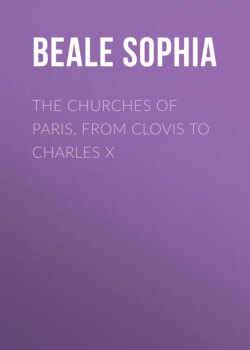Читать книгу The Churches of Paris, from Clovis to Charles X - Beale Sophia - Страница 9
SAINT-DENIS.
ОглавлениеAlthough the Benedictine abbey church of S. Denis is some miles from Paris, it is so mixed up with the history of the capital that it ought not to be omitted in a series of "Paris Churches." Moreover, as it is by far the finest church in, or near, the metropolis, and one of the grandest examples of French 13th century architecture, no one ought to grudge the tiresome journey by train or tram in order to see it, even if his stay in Paris be limited to a few days. The only thing required to make it perfectly beautiful is new stained glass in the windows of the clerestory to replace that put up during the early years of this century, a horrible example of the execrable taste of the period.
THE ABBEY CHURCH FROM THE GRANDE PLACE.
S. Denis was one of the sacred spots of mediæval Europe—a species of Christian Mecca. "Si les lieux sont reputez saincts," says one of its children, Dom Millet,[9] "à cause des choses sainctes faictes ou aduenuës en iceux, comme ont esté est sont encores, les montagnes de Thabor et de Caluaire, ou bien à cause des choses sainctes qu'ils contiennent, comme estoit l'Arche d'Alliance, et le Sancta Sanctorum des Juifs; je croy qu'il n'y a personne qui n'aduoüe que l'Eglise de S. Denys en France ne soit vn lieu tres-sainct en toutes ces considerations, puis qu'elle a esté dediée des propres mains de nostre Sauueur Jesus-Christ, descendu exprés du Ciel auec vne grande multitude d'Anges et de Saincts, et qu'elle contient en soy tant des choses sainctes, et des Reliques si precieuses et rares." It was a poor but worthy leper who saw this strange vision. He had been left shut up in the church, when in the dead of night he was startled by a dazzling light; and then he beheld the Saviour, His Apostles, multitudes of Angels, and S. Denis and his companions. Our Lord sprinkled the church with holy water, and S. Denis and his companions served Him; and then He said to the leper: "Go and tell le bon roy Dagobort what thou hast seen." "But how can a poor leper penetrate the presence of the King?" said he. Then a wondrous miracle was performed; the Saviour touching him with his finger, made the leper clean. Then he went to the King, and they all believed.
Not only was S. Denis specially favoured by this miraculous dedication, but it was privileged by Charlemagne in a charter, as the chief and mistress of all the churches in the kingdom; and its abbot as the Primate of all the prelates of France. This great man was allowed to have six deacons vested in dalmatics whenever he officiated, an honour conferred upon him by Pope Stephen III. when he consecrated the High Altar in 753, and at the same time anointed and crowned King Pépin and Queen Bertrade, and their two sons Charles and Carloman. People, high and low, from all the ends of the earth, flocked to the famous abbey as we now rush to the World's Fairs; and the great ones of the earth, princes, nobles, and ambassadors, considered that they had seen nought of the civilised world if they had not paid their respects to the relics at S. Denis. Some went for love, some out of sheer curiosity to see the riches of the treasury: divers crosses, reliquaries, statues, vases, chalices, and other vessels for the altars; S. Denis' mitre, chalice, and rings; the famous head of solid silver gilt, containing his skull, and presented to the abbey by Marguerite de France in 1360; a wonderful golden cup enriched with precious stones which had belonged to King Solomon, and a rock crystal vase from the Temple of the wise man—both the gift of Charles the Bald. He, being abbot, made it his custom to attend "the duties of his station at the Abbaye, on the solemn festivals, passing the day in pious conversation with the monks and in religious observances." He also made considerable donations,[10] added to the many lamps which are kept continually burning before the shrines, and increased the number of wax tapers employed in the services of the church. Then further, amongst the curiosities, were the nail of a griffin upon a silver-gilt animal; a unicorn's horn six feet high, sent by Aaron King of Persia to Charlemagne; the hunting horn of Roland, nephew of Charlemagne; and the lantern which was used at the betrayal of our Lord in the Garden, called the Lantern of Judas. The latter was of copper, embellished by rock crystal, through which the light shone. (This was also the gift of Charles the Bald). The mirror of the prince of poets, Virgil, which was of jet; the sword of the genereuse Amazone, Jeanne la Pucelle. Of the beauty of the croziers and pastoral crosses, the mitres and episcopal rings, Dom Millet's description leaves no doubt; and of the magnificence of the abbots, and the splendour of their monastery, we have more than ample evidence. As an old epigram puts it:
